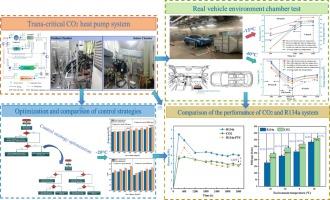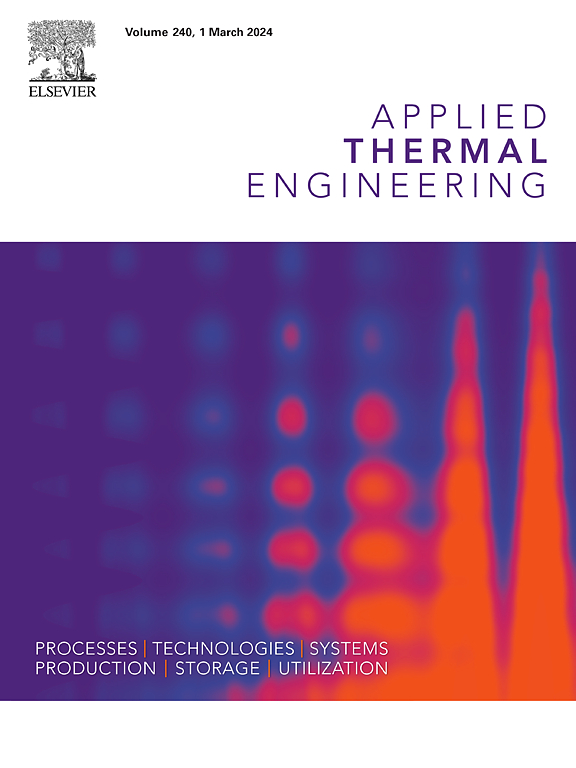采用新型控制策略的二氧化碳热泵系统在电动汽车中的性能研究
IF 6.1
2区 工程技术
Q2 ENERGY & FUELS
引用次数: 0
摘要
热管理系统的效率对电动汽车(EV)至关重要。本研究提出了一种新型双电子膨胀阀(EXV1 和 EXV2)分区控制策略,以改善二氧化碳热泵(HP)系统在低温下的加热性能。研究分析了 EXV1 开启对系统运行参数的影响。随后,对-20 °C下优化控制策略前后的加热能力、COP和气体冷却器(GC)出口空气温度进行了对比评估。研究提出了一种在加热和制冷条件下进行性能评估的方法,并使用环境试验室中的真实车辆进行了验证。此外,该研究还比较了二氧化碳和 R134a 系统在-20 °C时的能耗差异。研究还利用世界轻型车辆测试循环(WLTC)比较了这两种系统在不同温度下对车辆续航里程的影响。结果表明,当 EXV1 开度超过 300 级(30%)时,它对系统组件工作参数的影响较小。此外,在-20 °C时,优化控制策略使平均加热能力和COP分别提高了11.6 %和9.8 %,GC平均出口空气温度提高了8.2 °C。目标热管理系统可以满足加热和制冷需求。40 °C 时,出口空气的最低温度为 5.24 °C,-15 °C 时,出口空气的最高温度为 57.16 °C。在零下 20 °C时,二氧化碳 HP 系统比 R134a 系统节省约 34.7 % 的能耗。在 WLTC 条件下,二氧化碳 HP 系统与 R134a 系统相比,在-20 °C 和 -10 °C时的续航能力分别提高了 9.3 % 和 16.6 %。本文章由计算机程序翻译,如有差异,请以英文原文为准。

Performance research on a CO2 heat pump system with novel control strategy in electric vehicle
The efficiency of the thermal management system is crucial for electric vehicles (EVs). This study proposes a novel dual electronic expansion valve (EXV1 and EXV2) sub-area control strategy to improve the heating performance of the CO2 heat pump (HP) system in low temperatures. The study analyzed the impact of the EXV1 opening on the system’s operating parameters. A comparison assessment was subsequently conducted on the heating capacity, COP, and gas cooler (GC) outlet air temperature before and after optimizing the control strategy at −20 °C. A method for evaluating performance under heating and refrigerating conditions was proposed and validated using a real vehicle in the environmental chamber. Additionally, the study compared the energy consumption differences between the CO2 and R134a systems at −20 °C. The effects of these two systems on vehicle range at various temperatures were also compared using the WLTC (World-Light-Vehicle-Test-Cycle). The results show that when the EXV1 opening is exceeds 300 steps (30 %), it has less influence on the operating parameters of the system components. Furthermore, at −20 °C, the optimized control strategy improved the average heating capacity, and COP by 11.6 %, and 9.8 %, respectively, and the GC average outlet air temperature by 8.2 °C. The target thermal management system can meet the heating and refrigerating demands. The minimum temperature of the outlet air can be 5.24 °C at 40 °C and the maximum temperature of the outlet air can be 57.16 °C at −15 °C. The CO2 HP system saves about 34.7 % of energy consumption compared with the R134a system at −20 °C. Under the WLTC, the range of the CO2 HP system is improved by 9.3 % and 16.6 % compared to the R134a system at −20 °C and −10 °C, respectively.
求助全文
通过发布文献求助,成功后即可免费获取论文全文。
去求助
来源期刊

Applied Thermal Engineering
工程技术-工程:机械
CiteScore
11.30
自引率
15.60%
发文量
1474
审稿时长
57 days
期刊介绍:
Applied Thermal Engineering disseminates novel research related to the design, development and demonstration of components, devices, equipment, technologies and systems involving thermal processes for the production, storage, utilization and conservation of energy, with a focus on engineering application.
The journal publishes high-quality and high-impact Original Research Articles, Review Articles, Short Communications and Letters to the Editor on cutting-edge innovations in research, and recent advances or issues of interest to the thermal engineering community.
 求助内容:
求助内容: 应助结果提醒方式:
应助结果提醒方式:


